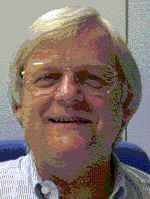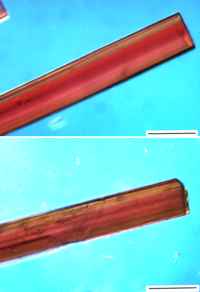Bacteriorhodopsin Crystal Growth under Microgravity: Flight Scenarios and Results
 |
Christian Zörb1, Andrea Weisert1, Jürgen Stapelmann2, Georg Smolik2, and Gottfried Wagner1
1Department of Biology, Justus-Liebig-University, D-35390 Gießen, Germany, and
2EADS Space Transport., D-88039 Friedrichshafen, Germany
e-mail: Gottfried.Wagner@bio.uni-giessen.de
URL: http://www.uni-giessen.de/~gf1114/rgwagner/agwagner.html
|
 |
For the purpose of bio-electronics, bacteriorhodopsin (BR) was crystallized into two habits through liquid-liquid-diffusion, namely individual needles of up to 1.9 mm in length and needle bunch-like clusters of up to 4.9 mm in total length (Micrograv. sci. technol. XIII, 2002). In the two low gravity experiments performed, the morphology of the individual needles had improved in terms of sharp needle edges and compact needle packing, compared to the parallel ground controls. (1) For the long duration wide range microgravity condition in the "Diffusion-controlled Crystallization Apparatus for Microgravity (DCAM)" on Mir, needle bunches on average were longer there than on the ground, while the compactness of the clusters, i.e. the average ratio of clustered length to clustered width was the reverse. Some exceptionally large individual needles were grown in DCAM. (2) For the "Commercial Protein Crystallization Facility (CPCF)" in short duration high definition microgravity condition during a science mission of the Space Shuttle Discovery (STS-95), size and shape of the individual needles were homogeneous and superior to those of both, the parallel ground controls and the results in DCAM. In CPCF, the average volume of the individual needles in suspension was increased by 50 % in microgravity compared to those in the ground control.
Acknowlegement: Thanks for DCAM flight support to Daniel C. Carter & Brenda S. Wright, New Century Pharmaceuticals, Inc., Huntsville, AL 35824, USA.


